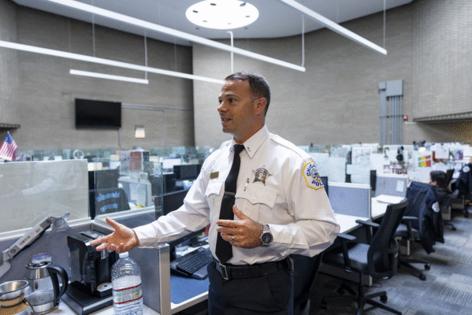Chicago police officers reporting use of force more often, as video becomes important training tool
Published in News & Features
CHICAGO — The woman stood on the sidewalk outside her home and waited for the first officers to show up. Blood streamed down her face and shoulders.
She had called 911 after her significant other stabbed her.
When officers arrived at the home in the Back of the Yards in July 2022, she pointed to the open doorway. Standing about 10 feet from the threshold, a man kept his grip on a knife in his right hand.
“Shoot me,” the man barked at the officers, as he took small, deliberate steps forward.
“Please drop the knife,” an officer, also on the sidewalk, yelled back. “I’m begging you. Drop the knife.”
As the man’s darkened silhouette continued forward, two red dots appeared: one on his chest, another on his thigh.
“Shoot me!” he demanded.
A moment later, a Taser was fired. A direct hit, splitting the man’s beltline. He fell backward, collapsing on the floor. An officer put down his Taser and put the man in handcuffs. One of the electrodes remained lodged in his shirt.
It was the type of deadly force encounter that’s routine for Chicago Police Department patrol officers in the city’s rougher neighborhoods. While common — CPD officers are called to thousands of domestic disturbances every year — the incident and others like it serve as valuable training material for the city’s Police Department in its post-Laquan McDonald era of reform.
A new report from CPD shows a sizable year-over-year increase in reports of both use-of-force and firearm-pointing incidents by Chicago cops. The upticks come as the department continues its efforts to gather and analyze internal data in its march toward compliance with the city’s federal consent decree.
After a use-of-force incident, CPD officers are required to fill out and submit a Tactical Response Report, or TRR. Those reports are used to detail the exact circumstances an officer faced when force was used: Was a suspect armed? Were other officers or civilians facing a threat? What were the weather and lighting conditions at the scene?
The CPD Tactical Review and Evaluation Division, or TRED, last year recorded 6,413 TRRs submitted by officers. That was a nearly 30% increase from 2023, when officers submitted 4,960 such reports.
In 2024, TRED recorded 5,204 instances of a CPD officer pointing their gun at someone, a 13% increase from 2023, when 4,513 such notifications were made.
Data from CPD’s Use of Force Dashboard shows officers are indeed using force more often than in recent years past, but CPD leaders are quick to credit the department’s training and internal messaging for the sizable increase. It means more officers are following protocols to report such exchanges.
“The seeds were planted years ago, and now we’re seeing the fruits of that labor,” CPD Deputy Chief Ralph Cruz, of the department’s Office of Constitutional Policing and Reform, told the Tribune earlier this month.
“It’s like being married; you’re always working at it,” he added.
The Police Department has 49 officers assigned to TRED, based in CPD’s Area 1 at 51st and Wentworth Avenue, including 10 sergeants. In addition to TRRs and firearm-pointing incidents, TRED also reviewed reports that stemmed from officer foot pursuits. While TRED can make recommendations after its reviews of body-worn camera footage and submitted reports, district-level supervisors are the ones who ultimately hold officer debriefings.
TRED analyzed 17,960 reports that were generated last year following an officer’s debriefing with a supervisor, with body-worn camera activation the most common debriefing topic.
Officer training and the department’s data collection practices have been sticking points in the city’s consent decree since it was entered by a federal judge in early 2019.
Body-worn cameras have become ubiquitous in CPD’s Bureau of Patrol over the last decade or so, ushering in a new era, ostensibly, of transparency and accountability. Timely activation of body-worn cameras has remained a challenge, though — one acknowledged in the recent report from TRED.
“Despite this, BWC compliance showed a downward trend in debriefing points throughout 2024, indicating positive growth,” the report said. “TRED personnel continues to conduct in-person training of Department members with four or more BWC debriefings within a 12-month period from the date of the incident. This in-service training highlights Illinois law, Department directives, Department streaming video, and overall proper usage of the body-worn camera.”
The incident debriefings are not punitive, but instead corrective, CPD officials say. Those one-on-one meetings can be held within days, if not hours, of an incident taking place. Also, if body-worn cameras capture an incident of suspected misconduct, CPD supervisors will make referrals to the department’s Bureau of Internal Affairs or the Civilian Office of Police Accountability.
For example, the officer’s response to the incident in the Back of the Yards was good, but CPD supervisors noticed room for improvement. The officer who fired his Taser was later subject to additional training because, CPD officials said, he placed the weapon on the ground within reach of civilians, potentially endangering himself and other officers.
By the end of 2025, all incidents of firearm pointing will be reviewed by the captain assigned to each of CPD’s 22 patrol districts. CPD leaders believe that any corrective measures issued by a captain are more likely to take hold because those supervisors — typically the second-highest ranking officer in a district — can better understand an officer’s day-to-day stresses and challenges.
Meanwhile, data also shows CPD supervisors more frequently turning to internal controls to correct misconduct behavior by the city’s officers while the future of CPD’s larger discipline apparatus remains hazy.
____
©2025 Chicago Tribune. Visit at chicagotribune.com. Distributed by Tribune Content Agency, LLC.







Comments